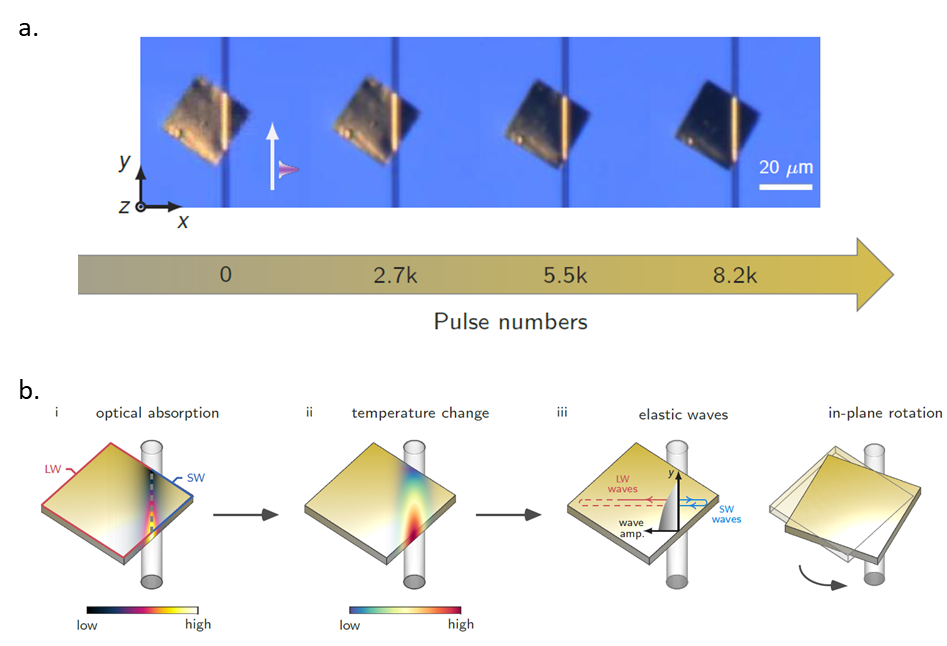Innovation: In this work, the in-plane rotation of micro-scaled gold plate is actuated by laser pulses guided into the microfiber in non-liquid enviroment. Qiu_Lab in Westlake University proposed to take advantage of elastic waves induced by optical absorption. Furthermore, the underlaying physical mechanisms supported with numerical simulations are examined, highlighting the joint role of the spatial gradient of optical absorption and the asymmetry in two wings of the plate.
Key words: Laser & Photonics Reviews, Multiphysics, Opto-thermal-elastic process, Light-induced actuation, Westlake University, Qiu_Lab

Figure 1. a. Sequential optical images recording the in-plane rotation of the gold plate.
b. Sketch of a three-step physical process involved in the in-plane rotation.
Conventional optical manipulation is based on a straightforward principle: light waves carry momentum that can transfer to objects during scattering and absorbing processes, and, accordingly, enable their motions. The transfer of linear momentum results in pushing or pulling optical forces that are used for optical trapping, while the transfer of angular momentum induces mechanical torques causing objects to rotate. Due to its unique advantages of precision, immediacy, and miniaturization, optical manipulation of micro-and nano-objects has proved to be an indispensable tool in many applications, such as biological manipulation and detection, micro-flow control, and particle delivery.
Optical force produced by momentum transfer is at a level of pN. As a result, despite its great success, the state-of-the-art optical manipulation is largely limited in low-adhesive environments, such that micro-objects are either immersed in liquids or levitated in vacuum. On solid (nonliquid) interfaces, optical manipulation is widely regarded as difficult due to the magnitude gap between tiny optical force and strong friction (adhesive) resistance (≈ μN).
In 2019, Qiu_lab showed rotary locomotion of a micrometer-sized metal plate, revolving around a microfiber. This motor was powered by pulsed light guided into the fiber as a coordinated consequence of an optically excited Lamb wave on the plate and favorable configuration of plate-fiber geometry (Science Advances 5. 3 (2019)).
Afterward, the actuation system has been further studied in other pioneering works. In 2021, a theory that took microscopic interactions between friction force and thermally excited elastic waves into account—supplemented with an illustrative case study—was established. In the same time, two-dimensional spiral motions of gold plates were observed experimentally (Light: Science & Applications 10, 193 (2021)). Similar to optical waves, elastic waves also carry momentum and transmit force. With the same amount of scattering power, the force induced by elastic waves could be easily six orders of magnitude larger than that by optical waves so that can overcome the adhesion force on solid interfaces.
Here, this article is based on previous studies. By delivering laser pulses into the microfibers, the micro-objects absorb light, which is converted into heat and, then, excites elastic waves to actuate the in-plane rotation of the micro-objects. Characterized by the optical microscope, the in-plane rotation of the microplate is similar to the micro-scaled fan blade. The combined experimental and theoretical results characterize and demonstrate the multiple physics coupled mechanism in this system. This work is recently published as ‘Light-Induced In-Plane Rotation of Micro-objects on Microfibers’ in Laser & Photonics Reviews (DOI: 10.1002/lpor.202100561). Ph. D. student Wei Lyu is the first author and Dr. Weiwei Tang, Dr. Wei Yan and Prof. Min Qiu are corresponding authors.
In this article, we experimentally demonstrate the light-induced in-plane rotation of gold plates on microfibers. We reveal the underlying mechanism of the in-plane rotation that relates to the thermally excited elastic waves by optical absorption, and stress the interplay between the gradient distribution of optical absorption and the asymmetry in the two wings of the gold plates divided by the microfibers. The combined experimental and theoretical results offer new insights into the study of the light-induced actuation of the micro-objects in nonliquid environments, an emerging field far from being mature in both comprehensive understanding and practical applications. This new mechanism has not been reported before. It shows that the spatial profile of the optical absorption can be used as a new degree of freedom to control microscale actuation in nonliquid environments.
We envision that our finding can inspire new applications in several aspects. First, detecting the in-plane rotation can provide a convenient approach to infer the distribution of the absorbed optical power. Second, by engineering spatial profiles of the absorbed optical power, it is in principle able to control the specific trajectory of the in-plane motion. This can be further used for modulating integrated optical circuits by precisely controlling positions of gold plates on waveguides that can affect couplings between nearby waveguides.
Information of the article:
Light-Induced In-Plane Rotation of Microobjects on Microfibers
Wei Lyu, Weiwei Tang*, Wei Yan*, and Min Qiu*
Laser & Photonics Reviews
DOI: 10.1002/lpor.202100561
Reprinted from: AdvancedScienceNews

